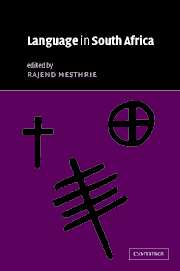Book contents
- Frontmatter
- Contents
- List of maps
- List of contributors
- Acknowledgements
- List of phonetic symbols
- List of abbreviations
- Introduction
- Part I The main language groupings
- Part II Language contact
- 9 Fanakalo: a pidgin in South Africa
- 10 Mutual lexical borrowings among some languages of southern Africa: Xhosa, Afrikaans and English
- 11 Code-switching, mixing and convergence in Cape Town
- 12 Code-switching in South African townships
- 13 Intercultural miscommunication in South Africa
- 14 Women's language of respect: isihlonipho sabafazi
- 15 The sociohistory of clicks in Southern Bantu
- 16 The political economy of language shift: language and gendered ethnicity in a Thonga community
- 17 From second language to first language: Indian South African English
- 18 Black South African English
- 19 The lexicon and sociolinguistic codes of the working-class Afrikaans-speaking Cape Peninsula coloured community
- 20 An Introduction to Flaaitaal (or Tsotsitaal)
- 21 Language and language practices in Soweto
- Part III Language planning, policy and education
- Index
- References
15 - The sociohistory of clicks in Southern Bantu
from Part II - Language contact
Published online by Cambridge University Press: 22 September 2009
- Frontmatter
- Contents
- List of maps
- List of contributors
- Acknowledgements
- List of phonetic symbols
- List of abbreviations
- Introduction
- Part I The main language groupings
- Part II Language contact
- 9 Fanakalo: a pidgin in South Africa
- 10 Mutual lexical borrowings among some languages of southern Africa: Xhosa, Afrikaans and English
- 11 Code-switching, mixing and convergence in Cape Town
- 12 Code-switching in South African townships
- 13 Intercultural miscommunication in South Africa
- 14 Women's language of respect: isihlonipho sabafazi
- 15 The sociohistory of clicks in Southern Bantu
- 16 The political economy of language shift: language and gendered ethnicity in a Thonga community
- 17 From second language to first language: Indian South African English
- 18 Black South African English
- 19 The lexicon and sociolinguistic codes of the working-class Afrikaans-speaking Cape Peninsula coloured community
- 20 An Introduction to Flaaitaal (or Tsotsitaal)
- 21 Language and language practices in Soweto
- Part III Language planning, policy and education
- Index
- References
Summary
INTRODUCTION: CLICKS IN SOUTHERN AFRICA
The click consonants of southern Africa are such pervasive elements within the indigenous Khoesan languages and so striking to the ear that the earliest explorers and missionaries to this area frequently commented on the very distinct acoustic quality of local languages. Such commentary was most often negative:
Among the Hottentot dialects, none is so rough and wild, and differs so much from the rest, as that of the Bosjesmans, so that it is scarcely understood by any of the other tribes. It is, in the first place, much poorer in sounds: many sounds, which may be expressed by our letters … are either totally wanting among them, or occur rarely. Pure vowels are seldom to be heard; but the cluck and the diphthongs are much more frequent. The cluck, in particular, seems the most completely at home among them: scarcely a word occurs without it.
(H. Lichtenstien, cited in Theal 1910: 19–20)The peoples and languages of southern Africa soon attracted the attention of linguistic and cultural evolutionary theorists, who saw southern African hunters and their languages as representing ‘primitive types’. The view, first expressed by van Ginneken (1911: 346–7), that clicks were the phonetic material from which human language first arose was developed and ardently championed by the Polish linguist Roman Stopa (1935, 1979). Clicks were seen as arising from ‘the condensed expression of the gesticulatory part of speech’ (Stopa 1979: 28).
- Type
- Chapter
- Information
- Language in South Africa , pp. 297 - 315Publisher: Cambridge University PressPrint publication year: 2002
References
- 5
- Cited by



